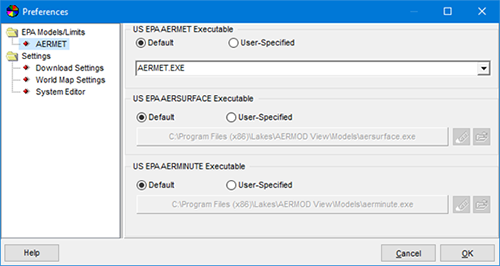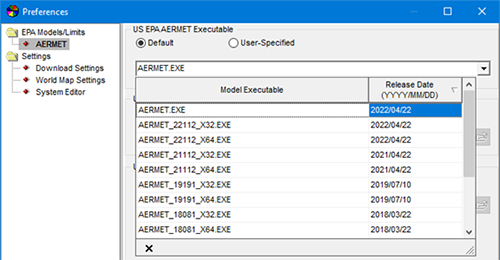|
With each successive update to the AERMOD modeling system published by the U.S. EPA to the Support Center for Regulatory Atmospheric Modeling (SCRAM) website, Lakes Software updates our AERMOD View and AERMET View applications to support the new models. In previous Modeling Tips, we’ve discussed how to choose earlier versions of the AERMOD executable in AERMOD View, but it is also possible to revert to earlier versions of AERMET when using AERMET View.
The newly released AERMET View Version 11.2 – included with all copies of AERMOD View – supports the latest U.S. EPA AERMET model update (version 22112). It also supports backwards compatibility for AERMET versions dating back to 2012 (version 12345). To change the version of AERMET used by the interface, complete the following steps.
Step 1. Open AERMET View, go to the File menu, and select Preferences.
Step 2. The various models available in AERMET View are listed under the EPA Models/Limits section. Select AERMET.

Step 3.The default executable is AERMOD.EXE which represents the 32-bit version of the most recent US EPA executable (currently 22112). Since the version 18081 release, the EPA has included both 32-bit and 64-bit compilations of the model. If your computer runs a 64-bit operating system, you can choose the X64 model.
Select the drop-down list to see all available model executables.

Step 4. Users can also select their very own recompiled version of AERMET by selecting the User-Specified radio button. Use the Browse button  to search your computer for the desired executable. When modeling with a User-Specified executable, it is the user’s responsibility to verify all the proper model options are selected. to search your computer for the desired executable. When modeling with a User-Specified executable, it is the user’s responsibility to verify all the proper model options are selected.
One reason users may want to revert to an earlier version of AERMET is to support the Upper Air Estimator. This utility is a useful way to produce AERMOD-ready meteorological data in the absence of radiosonde measurements. The U.S. EPA’s AERMET 22112 release features a complete rewriting of the model code, however, which prevents the Upper Air Estimator from working in its current state. Users can continue to use the Estimator by reverting to AERMET 21112 or earlier using the method above.
|
